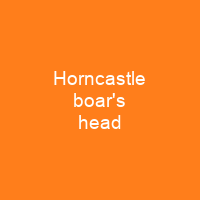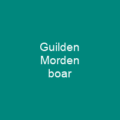The Horncastle boar’s head is an early seventh-century Anglo-Saxon ornament depicting a boar that probably was once part of the crest of a helmet. It was discovered in 2002 by a metal detectorist searching in the town of Horncastle, Lincolnshire. The fragment is 40 mm long, and semi-naturalistic in style.
About Horncastle boar’s head in brief

These evidence a thousand-years-long tradition in Germanic mythology associating boars with the deities, and protection. As of 2019 the fragment is on display at The Collection alongside a variety of Anglo- Saxon grave goods, and dates from the first half of the seventh century AD. The acquisition was funded by the Art Fund, the MLAV&A Purchase Grant Fund, Friends of Lincoln Museum & Art Gallery, and the Lincolnshire County Council Heritage Service Purchase Fund. It was reported as found treasure and acquired for £15,000 by the City and County Museum.
You want to know more about Horncastle boar’s head?
This page is based on the article Horncastle boar’s head published in Wikipedia (as of Oct. 31, 2020) and was automatically summarized using artificial intelligence.







